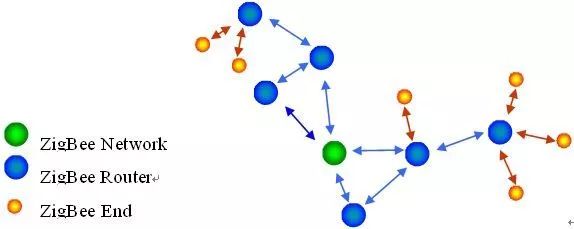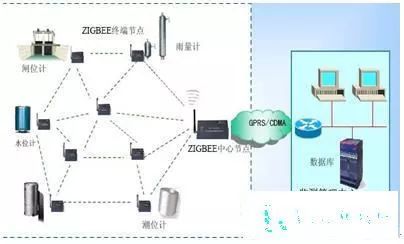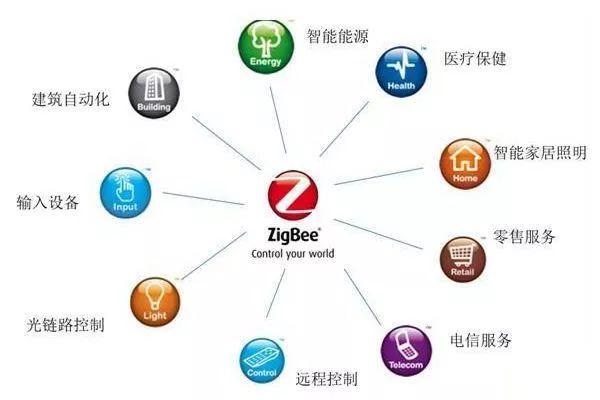
Author | Sensor Technology
Today, communication technology is developing rapidly. With the swift growth of the Internet and the increasing demand for data communication, the global communication industry is witnessing three major trends: wireless, broadband, and IP-based technology. The development of Internet services has driven the market’s demand for broadband networks, leading to a strong increase in broadband user numbers worldwide. Among various broadband technologies, wireless technology, especially mobile communication technology, has become the biggest highlight in the communication technology market in recent years and is an important component of future communication technology.

ZigBee is a low-power personal area network protocol based on the IEEE802.15.4 standard. According to the specifications of this protocol, it is a short-range, low-power wireless communication technology. The name comes from the figure-eight dance of bees, as bees communicate the location of pollen to their companions by flying and buzzing (zig) their wings. In other words, bees form a communication network within their group in this way. Its characteristics include short-range, low complexity, self-organization, low power consumption, and high data rate. It is mainly suitable for automatic control and remote control fields and can be embedded in various devices. In short, ZigBee is a cheap, low-power, short-range wireless networking communication technology.
The Origin and Development of ZigBee Technology
Before introducing ZigBee, it is important to mention its predecessor—Bluetooth. During the use of Bluetooth technology, people found that despite its many advantages, Bluetooth still had many shortcomings. For industrial and home automation control, as well as industrial telemetry and remote control, Bluetooth technology is too complex, has high power consumption, short range, and a small network scale. The demand for wireless data communication in industrial automation is becoming increasingly strong, and this wireless data transmission must be highly reliable and resistant to various electromagnetic interferences in industrial environments. Therefore, after long-term efforts, the ZigBee protocol was officially launched in the United States in 2003.
ZigBee’s predecessor was the “Homerflite” technology initiated in 1998 by industry giants such as INTEL and IBM.
In December 2000, a working group was established to draft the IEEE802.154 standard, and the ZigBee Alliance was founded in August 2001.
In the second half of 2002, four major companies—Vensys from the UK, Mitsubishi Electric from Japan, Motorola from the USA, and Philips Semiconductor from the Netherlands—announced their membership in the ZigBee Alliance to develop the next-generation wireless communication standard named “ZigBee.” This event became a milestone in the development of this technology.
In December 2004, the ZigBee 1.0 standard (also known as ZigBee 2004) was finalized, establishing the basic development standard for ZigBee.
In September 2005, the ZigBee 1.0 standard was published and made available for download. That year, Huawei Technologies Co., Ltd. and IBM joined the ZigBee Alliance. However, applications based on this version were few and incompatible with later versions.
In December 2006, a standard revision was made, and the ZigBee 1.1 version (also known as ZigBee 2006) was released. Although named ZigBee 1.1, it is not compatible with ZigBee 1.0.
In October 2007, another revision was completed (known as ZigBee 2007/PRO), which was compatible with the previous ZigBee 2006 version and included ZigBee Pro. At this time, the ZigBee Alliance focused more on three areas: home automation, building commercial automation, and advanced metering infrastructure.
The Technical Principles of ZigBee
ZigBee is a wireless data transmission network platform composed of up to 65,000 wireless data transmission modules, quite similar to existing mobile communication CDMA or GSM networks. Each ZigBee network data transmission module is akin to a base station in a mobile network, allowing mutual communication within the network range. The distance between each network node can range from a standard of 75 meters to several hundred meters or even kilometers after expansion. Additionally, the entire ZigBee network can connect with various existing networks. For example, you can monitor a ZigBee control network in Yunnan from Beijing via the Internet.

The ZigBee network is primarily established for automated control data transmission, whereas mobile communication networks are primarily for voice communication. The value of each mobile base station is generally over one million yuan, while each ZigBee “base station” costs less than 1,000 yuan. Each ZigBee network node can not only connect directly to monitoring objects, such as sensors, for data collection and monitoring but can also automatically relay data from other network nodes. Furthermore, each ZigBee network node (FFD) can wirelessly connect with multiple isolated sub-nodes (RFD) that do not undertake network information relay tasks within its signal coverage area.
Each ZigBee network node (FFD and RFD) can support up to 31 sensors and controlled devices, each of which can have eight different interface types. It can collect and transmit both digital and analog signals.

Characteristics of ZigBee Technology
ZigBee technology is a bidirectional wireless communication technology characterized by short-range, low complexity, low power consumption, low data rate, and low cost. It is mainly used for data transmission between various electronic devices with short distances, low power consumption, and low transmission rates, as well as applications involving periodic data, intermittent data, and low response time data transmission.
Since Marconi invented radio, wireless communication technology has been continuously developed towards higher data rates and transmission distances. For example, the third-generation mobile communication network (3G) aims to provide multimedia wireless services within wide area networks, while local area network standards have evolved from IEEE802.11’s 1Mbit/s to IEEE802.11g’s 54Mbit/s data rates. ZigBee technology, on the other hand, aims to provide a low-cost, fixed, portable, or mobile device wireless communication technology with extremely low complexity, cost, and power consumption.
This wireless communication technology has the following characteristics:
Low Power Consumption
In operational modes, ZigBee technology has low transmission rates and small data volumes, resulting in short signal send/receive times. Additionally, in non-operational modes, ZigBee nodes remain in sleep mode. The device search delay is generally about 30ms, the sleep activation delay is 15ms, and the active device channel access delay is also 15ms. Due to the short working time and low information transmission power consumption, ZigBee nodes can be very energy-efficient, with battery lifetimes ranging from 6 months to around 2 years. Furthermore, since battery life depends on many factors, such as battery type, capacity, and application scenarios, ZigBee technology has also optimized battery usage within the protocol. For typical applications, alkaline batteries can last for several years, and in cases where the working time is less than 1% of the total time (working time + sleep time), the battery life can even exceed 10 years.
Reliable Data Transmission
The media access control layer (MAC layer) of ZigBee uses a talk-when-ready collision avoidance mechanism. Under this fully confirmed data transmission mechanism, data is transmitted immediately when a transmission demand arises, and each sent data packet must wait for acknowledgment from the receiver. If acknowledgment is not received, it indicates a collision, and the data will be retransmitted. This method improves the reliability of system information transmission. Additionally, it reserves dedicated time slots for communication services that require fixed bandwidth, avoiding competition and conflicts during data transmission. ZigBee has also optimized for time-sensitive applications, ensuring very short communication delays and sleep state activation delays.
Large Network Capacity
ZigBee’s low data rate, low power consumption, and short-range transmission characteristics make it very suitable for supporting simple devices. ZigBee defines two types of devices: full-function devices (FFD) and reduced-function devices (RFD). Full-function devices must support all 49 basic parameters, while reduced-function devices only need to support 38 basic parameters at minimum configuration. A full-function device can communicate with both reduced-function devices and other full-function devices, and it can operate in three modes: personal area network coordinator, coordinator, or device. Reduced-function devices can only communicate with full-function devices and are used for very simple applications. A ZigBee network can include up to 255 ZigBee network nodes, with one being the master device and the rest being slave devices. If connected through a network coordinator, the entire network can support over 64,000 ZigBee network nodes, and since various network coordinators can interconnect, the total number of ZigBee network nodes can be quite substantial.
Compatibility
ZigBee technology seamlessly integrates with existing control network standards. The network is automatically established through a network coordinator, using carrier sense multiple access/collision avoidance (CSMA-CA) for channel access. To ensure reliable transmission, a full handshake protocol is also provided.
Security
ZigBee provides data integrity checks and authentication functions, offering three levels of security during data transmission. The first level is essentially a non-secure mode; for certain applications where security is not important or sufficient protection is provided by upper layers, devices can opt for this mode for data transfer. For the second level of security, devices can use an access control list (ACL) to prevent unauthorized devices from accessing data, without encryption measures. The third level of security employs symmetric encryption based on the Advanced Encryption Standard (AES) during data transfer. AES can protect data payloads and prevent attackers from impersonating legitimate devices, allowing applications to flexibly determine their security attributes.
Low Implementation Cost
The initial cost of the module is estimated to be around $6, quickly dropping to $1.5-$2.5, and the ZigBee protocol incurs no patent fees. Currently, the price of low-speed, low-power UWB chipsets is at least $20. ZigBee’s price target is just a few cents. Low cost is a key factor for ZigBee.
Short Delay
Communication delays and delays from sleep state activation are very short, with typical device search delays of 30ms, sleep activation delays of 15ms, and active device channel access delays of 15ms. Therefore, ZigBee technology is suitable for wireless control applications that require strict delay requirements (such as industrial control scenarios).
Differences Between ZigBee and WiFi
Similarities:
1. Both are short-range wireless communication technologies;
2. Both use the 2.4GHz frequency band;
3. Both adopt DSSS technology;
Differences:
1. Different transmission speeds. ZigBee’s transmission speed is low (<250Kbps), but its power consumption is very low, allowing battery-powered devices to work for generally over three months; WiFi, commonly referred to as wireless local area network, has high speeds (11Mbps) but also high power consumption, typically requiring external power;
2. Different application scenarios. ZigBee is used in low-speed, low-power scenarios, such as wireless sensor networks, suitable for industrial control, environmental monitoring, smart home control, etc. WiFi is generally used for wireless network technology covering a certain range (such as a building) (coverage of about 100 meters). It manifests as the wireless routers we commonly use, where one wireless router is set up in a building, allowing laptops (with wireless network cards) within the building to connect to the Internet wirelessly.
3. Different market conditions. ZigBee, as an emerging technology, has been rapidly developing and promoting since the release of its first version of the standard in 2004. However, due to cost and reliability issues, it has not yet been widely promoted. WiFi is much more mature in technology and has many applications. In general, the differences between the two are significant, with different market positioning and not much competition between them. However, the two share common technical points, and mutual interference is relatively high, especially WiFi’s interference with ZigBee.
The hardware memory requirements comparison: ZigBee: 32~64KB+; WiFi: 1MB+; ZigBee has lower hardware requirements.
The comparison of battery-powered operational sustainability: ZigBee: 100~1000 days; WiFi: 1~5 days; ZigBee has low power consumption. The transmission distance comparison (general usage, without high-power antenna transmission devices): ZigBee: 1~1000M; WiFi: 1~100M; ZigBee has a longer transmission distance. ZigBee’s disadvantages: Network bandwidth comparison: ZigBee: 20~250KB/s; WiFi: 11000KB/s; ZigBee has lower bandwidth and slower transmission.
Applications of ZigBee Technology
As a low-speed, short-range wireless communication technology, ZigBee has its own characteristics, leading to tailored applications. Although there may be overlaps with other technologies in certain areas, some possible applications of ZigBee include smart homes, industrial control, automatic meter reading, medical monitoring, sensor network applications, and telecommunications applications.

Smart Home
Many households have numerous electrical and electronic devices, such as lights, televisions, refrigerators, washing machines, computers, air conditioners, and possibly smoke detectors, alarms, and cameras. Previously, users could only achieve point-to-point control, but with ZigBee technology, these electronic devices can be connected together to form a network, and even connected to the Internet via a gateway. This allows users to conveniently monitor their home situation from anywhere and eliminates the hassle of wiring in the house.
Industrial Control
In factory environments, there are many sensors and controllers that can be connected into a network using ZigBee technology for monitoring, enhancing operational management, and reducing costs.
Automatic Meter Reading
Meter reading is something most people are familiar with, such as gas meters, electric meters, and water meters, which need to be read and reported to gas, electricity, or water companies monthly or quarterly for billing. Currently, most places still use manual methods for meter reading, going door-to-door, which is very inconvenient. ZigBee can be used in this field to convert meter readings into digital signals using sensors and send the readings directly through the ZigBee network to the gas or water and electricity providers. Using ZigBee for meter reading also brings other benefits, such as allowing gas or electricity companies to send information directly to users or integrating with energy-saving features to automatically reduce usage when energy consumption is found to be too high.
Medical Monitoring
Electronic medical monitoring has recently become a research hotspot. Many sensors can be installed on the human body to measure pulse, blood pressure, and monitor health status, along with some monitors and alarms placed around the environment, such as in hospital rooms, to monitor a person’s health status at all times. If any issues arise, timely responses can be made, such as notifying the hospital staff on duty. These sensors, monitors, and alarms can form a monitoring network using ZigBee technology. Since it is a wireless technology, the sensors do not need wired connections, allowing the monitored individuals to move freely, which is very convenient.
Sensor Network Applications
Sensor networks are also a recent research hotspot, with great application prospects in areas such as goods tracking, building monitoring, and environmental protection. Sensor networks require nodes to be low-cost, low-power, capable of automatic networking, easy to maintain, and highly reliable. ZigBee’s advantages in networking and low power consumption make it a great technical choice for sensor network applications.
Telecommunications Applications
In early 2006, Telecom Italia announced the development of a SIM card integrated with ZigBee technology, named “ZSIM.” This SIM card is merely a means of integrating ZigBee into telecommunications terminals. The ZigBee Alliance also announced in April 2007 that its members were developing telecommunications-related applications. If ZigBee technology can indeed be developed in the telecommunications field, users will be able to use their mobile phones for mobile payments and receive interesting information, such as news and discounts, in hotspot areas. Users can also know their location through positioning services. Although current GPS positioning services are very effective, they struggle to support indoor positioning, which ZigBee’s positioning capability can help address.
Current Issues with ZigBee Technology
Although ZigBee technology was listed in 2004 as one of the ten fastest developing and most market-promising new technologies in the world, and many discussions have been held regarding its advantages, there are still very few meaningful cases where ZigBee technology has been fully utilized to solve specific practical problems.
ZigBee seems to have become a fashionable but currently impractical new technology. The reasons for this include the need for technical improvements and maturity, as well as market cultivation processes for this new technology. Additionally, in the long-term application of ZigBee technology to solve practical problems, we have identified several important issues that we believe are quite difficult to resolve in the short term:
1. One of ZigBee’s core technologies is dynamic networking and dynamic routing, meaning that the ZigBee network considers the addition and removal of nodes. Each node in the network needs to communicate wirelessly at certain intervals to re-establish the network. Furthermore, when sending information from one node to another, various potential paths must be scanned, starting with the shortest route. This involves managing the wireless network, which consumes a lot of bandwidth resources and increases data transmission delays, especially as the number of network nodes and relay attempts increase. Therefore, while ZigBee’s RF transmission rate is 250kbps, the actual usable rate after multiple relays will be significantly reduced, and data transmission delays will increase, making wireless network management more complicated. This is the primary issue faced by ZigBee networks during data transmission.
2. The word “ZigBee” is composed of “Zig” and “bee”. The former refers to a zigzag path, while the latter means bee. We understand that ZigBee network technology mimics the way bees communicate by transmitting information from one node to another through mutual transmission. According to general standards, if a ZigBee node in open space increases the straight-line transmission distance by an average of 50 meters for each data relay, transmitting a straight-line distance of 500 meters would require ten relays. Indoors, due to the 2.4G transmission frequency used by ZigBee, transmission typically occurs via signal reflection. Due to building obstructions, transmitting a certain distance often requires many network nodes to relay the data. As analyzed in the first point, this is not a simple task for a ZigBee network. Of course, we could use amplifiers to increase the transmission distance of ZigBee network nodes; however, this would significantly increase power consumption and costs, defeating the original purpose of ZigBee’s low cost and low power consumption. Moreover, using this method indoors to increase transmission distance has limited effectiveness. Obviously, a star network communication structure with a central point outdoors and terminal modules outdoors would be more reasonable.
3. One of ZigBee’s core technologies is that each network node, besides serving as an information collection point and executing commands from the center, also undertakes data relay tasks from the network. This means the receiver-transmitter of the network node must always be in send/receive mode, which indicates that its minimum power consumption is at least 20mA. Generally, network nodes using amplifiers for long-distance transmission consume power around 150mA, making it difficult to use battery power to ensure the normal operation of network nodes.
4. Since each node in ZigBee participates in automatic networking and dynamic routing, the microcontroller for each network node is relatively complex, leading to higher costs. Additionally, the amount of development work targeting specific applications based on the ZigBee network is also larger.
In summary, we believe that in many cases, ZigBee networks sacrifice network transmission efficiency, bandwidth, and power consumption of node modules to obtain dynamic networking and dynamic routing features, which are not crucial in many practical applications. In general, our network nodes and data transmission routes are often fixed. Therefore, the current unresolved issues with ZigBee technology regarding node power consumption, low efficiency of network data transmission, long delays, and limited transmission distances are fundamental reasons why ZigBee technology has not been widely promoted.

